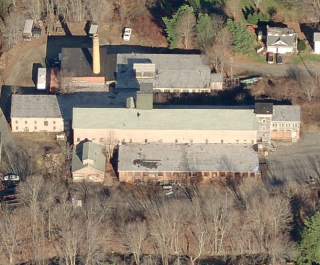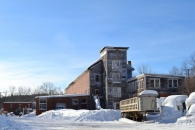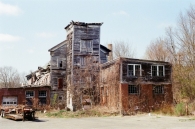Mill Record Stafford
RETURN TO ‘FIND MILLS’Disclaimer: Content for these properties was compiled in 2014-2017 from a variety of sources and is subject to change. Updates are occasionally made under Property Information, however the Connecticut Trust for Historic Preservation (dba Preservation Connecticut) makes no representation or warranty that the information is complete or up-to-date.
- Complex Name (Common)
- Phoenix Woolen Co. ROOF COLLAPSED by 2024
- Complex Name (Historic)
-
- Phoenix Woolen Co.
- Address or Location
- 108 Hydeville Road, Stafford
- County
- Tolland
- Historic Designation
- Associated Mill Community

- Historic Information
Companies Associated w/Complex
- A.W. Dolge Co. 1955-1976
- Hydeville Company 1860-1868
- Phoenix Woolen Co. 1868-1934
- Swift River Woolen Co. 1934-1955
Use (Historic)
Largest Documented Workforce
200 (ca. 1900)
Historic Narrative
The earliest portion of the Phoenix Woolen Company mill on Hydeville Road was erected for the Hydeville Company in 1860. In 1868, the factory was purchased by the newly-formed Phoenix Woolen Company, which was organized for the production of cassimeres and doeskins. The firm was initially led by Charles Holt, treasurer and agent, and Cyril Johnson, superintendant, with Holt becoming the sole owner in 1880 when he and Johnson parted ways. In 1886, Holt was joined by E.C. Pinney and Christopher Allen, who took over the company the following year when Holt left the firm. The Phoenix Woolen Company evolved during the late-19th century, eventually adding the production of kerseys, meltons, and vicunas to their line of woolen fabrics. The firm employed roughly 50 hands tending five sets of carding machines and 17 broad looms. Following Holt’s departure in 1887, Allen assumed the role as the Phoenix Woolen Company’s president and superintendent. In 1891, Pinney was elected treasurer, and then in 1893 he took over as president. Around this time, Pinney’s son, Charles B. Pinney joined the firm, as did Hiram Rathbun, who served as superintendant. These men oversaw a doubling of the company’s business and by 1895 the firm employed about 100 workers running 35 looms. The firm still only possessed five carding machines, resulting in the need to run two shifts in order to keep up with demand. The Phoenix Woolen Company continued to thrive during the early-20th century by adapting to the times and ever-changing fashion trends. The company shifted all its resources towards the production of fabrics for Navy overcoats following the outbreak of World War One, and then after the war took up the production of cloth used for billiard tables and automobile interiors as fashions moved away from the heavy, durable fabrics the firm had previously manufactured. The company introduced a line of women’s wear around 1930, but in 1934 was forced to sell its mill to the Swift River Woolen Company of Westerly, Rhode Island. After taking over the Hydeville Mill, the Swift River Woolen Company primarily focused on the production of lightweight women’s wear. This continued until 1955 when the firm closed the Stafford plant and put it up for auction. The mill was subsequently purchased by the A.W. Dolge Company, a wool processing firm that had been formed in Hazardville, Connecticut, in 1952, by Albert W. Dolge, Donald W. Dolge, and David B. Dolge. The company initially employed just over 30 hands, however, by the late-1960s this had been reduced to around twelve. The company eventually ceased operations in 1976.
- Architectural Information
Number of Existing Buildings
Eight (8) adjoining primary blocks.
Dates of Construction
1860, ca. 1870, ca. 1905, ca. 1915, ca. 1940, ca. 1955.
Architect
n/a
Builder
n/a
Building Type
Architectural Description
The former Phoenix Woolen Company plant is comprised of eight adjoining blocks and a freestanding two-block storage building located on the west side of Hydeville Road, just north of East Street (CT Route 19) and Furnace Brook. The core of the plant consists of a three-and-a-half-story, 38’ x 196’ manufacturing building erected in 1860. The building’s first story is constructed of coursed ashlar granite and the upper floors are frame. The facade (east) elevation is sheathed with clapboard, while the remaining elevations have wood shingle siding. The building has a front-gabled roof with wood cornice, cornice returns, and plain rake boards. A four-story frame stair tower with paired doors on each floor and a hoist beam at the roofline is centered on the façade. Evenly-spaced double-hung wood windows originally spanned the length of all three stories of the side elevations, however, the majority of these, as well as a course of attic-story windows, were covered up when the building was shingled (at an unknown date since the 1980s), leaving only the second-floor windows exposed. The earliest additions to the mill were likely completed ca. 1870 and consisted of a one-and-a-half-story dye house since raised and incorporated into the western end of the main block; a two-story, 32’ x 138’ granite and brick picker room, powerhouse, and wool storage building erected adjoining the northwest corner of the mill; and a two-story, 31’ x 63’ ashlar granite storage building that stands roughly 70’ west of the main manufacturing building. The second of these structures originally had a front-gabled roof, however, this was damaged by fire and replaced with a flat roof ca. 1943. Another round of additions to the mill were completed ca. 1905. They include a one-story, 14’ x 88’ drying building on the north side of the main block, and a one-story, 54’ x 100’ red brick carding building located 40’ north of the main block on the opposite side of a millrace leading from Hyeville Pond roughly 600’ to the east. Further blocks were erected ca. 1915, these consisting of a two-story, 26’ x 66’ red brick and frame shipping building adjoining the northeast corner of the original building; a one-story, 16’ x 150’ red brick inspection building erected along the south side of the main building (this enlarged ca. 1955); and a two-story, 31’ x 50’ red brick storage building built adjoining the south side of the freestanding ca. 1870 storage building. The final blocks associated with the plant consist of a one-and-a-half story, 40’ x 36’ frame shipping building with a gable roof and clerestory monitor built at the southwest corner of the original building ca. 1940; and a one-story, 45’ x 48’ red brick boiler house with flat roof erected at the northwest corner of the complex ca. 1955.
Exterior Material(s)
Structural System(s)
Roof Form
Roof Material
Power Source
Condition
Fair, Deteriorated
Condition Notes
The factory is in fair to deteriorated condition. The clapboard and wood shingles along the exterior walls of the original mill, as well as its wood windows, cornice, and gable roof, are all heavily deteriorated. Later additions to the factory appear to be in somewhat better condition, however, most are in need of a certain degree of maintenance
- Property Information
-
Specific Location
The complex is presently comprised of two legal parcels (106 and 108 Hydeville Road) totaling 4.0 acres located on the west side of Hydeville Road, just north of East Street (CT Route 19) and Furnace Brook.
Adjacent To
Exterior Visible from Public Road?
Yes
Parcel ID / Assessor Record Link
Acreage
n/a
Use (Present)
- Sources
-
Form Completed By
Lucas A. Karmazinas
Date
02/24/2015
Bibliography
- Map of Tolland County, Wm. C. Eaton & H.C. Osborn, 1857.
- Atlas of Tolland County, O.W. Gray, 1869.
- Sanborn Map Company, 1884, 1892, 1897, 1911, 1921, 1930, 1943.
- Aerial Survey of Connecticut, 1934, 1965.
- Birdseye View of Stafford Springs, Conn., O.H. Bailey & Co., 1878.
- List of Connecticut Manufacturers, 1922, 1924, 1930, 1932.
- Directory of Connecticut State Manufacturers, 1936, 1939.
- Industrial Directory of Connecticut, 1947.
- Register of War Production Facilities in Connecticut, 1951.
- Hartford Courant, 1960, 1976.
- History of the Town of Stafford, Stafford Library Assoc., 1935.
- Stafford, Connecticut, 250th Anniversary, 1969.
- Stafford Illustrated, Young, William, 1895.
- Town of Stafford HRI, Gibbs, James, 1993.
- Roth, Matthew, et al, Connecticut: An Inventory of Historic Engineering and Industrial Sites (Washington DC: SIA, 1981).
- Representative View(s)Click on image to view full file






